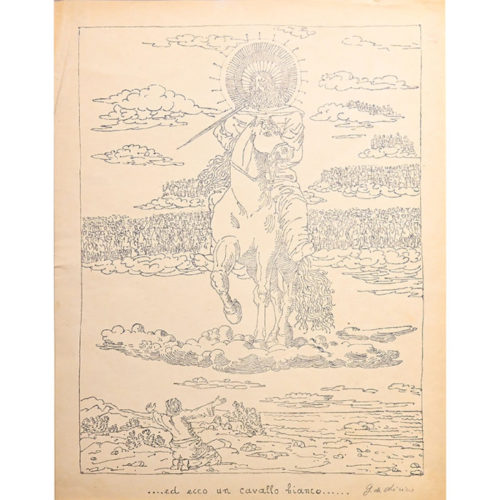Drop chandelier dating back to the 1950s, with volute structure in iron rod. Equipped with six light points
-
Out of stock
 "Ed ecco un cavallo bianco (And finally a white horse)", a not numbered litograph, signed on the lower right by Giorgio De Chirico. This artwork is included in the "Apocalypse" volume, curated by R. Carrieri, Edizioni della Chimera, Milano. The founder of the metaphysical school, Giorgio de Chirico is mostly known for his metaphysical paintings, created from 1909 to 1919. These nostalgic representations have deeply influenced the Surrealist movement and its artists, among which André Breton, Salvador Dalì and René Magritte. De Chirico's artworks explore various themes, among which alientation; nostalgia and the myth. De Chirico refused, later in his career, his previous metaphysical style and focused his research on traditional painting techniques, preferring the neo-Classic and neo-Baroque style, influenced by Raffaello, Luca Signorelli and Peter Paul Rubens. The surrealists publicly criticised this further anti-moidernist development in De Chirico's work and for that the artist ceased his participation and belonging to the group. Measurements: In frame H53 x W45,5 x D1,5 cm / Litograph H32 x W25 cm.
"Ed ecco un cavallo bianco (And finally a white horse)", a not numbered litograph, signed on the lower right by Giorgio De Chirico. This artwork is included in the "Apocalypse" volume, curated by R. Carrieri, Edizioni della Chimera, Milano. The founder of the metaphysical school, Giorgio de Chirico is mostly known for his metaphysical paintings, created from 1909 to 1919. These nostalgic representations have deeply influenced the Surrealist movement and its artists, among which André Breton, Salvador Dalì and René Magritte. De Chirico's artworks explore various themes, among which alientation; nostalgia and the myth. De Chirico refused, later in his career, his previous metaphysical style and focused his research on traditional painting techniques, preferring the neo-Classic and neo-Baroque style, influenced by Raffaello, Luca Signorelli and Peter Paul Rubens. The surrealists publicly criticised this further anti-moidernist development in De Chirico's work and for that the artist ceased his participation and belonging to the group. Measurements: In frame H53 x W45,5 x D1,5 cm / Litograph H32 x W25 cm. -
Out of stock
 Period: 1950s Measurements: H 121 x Ø 40 cm50's hourglass floor lamp, in opaline
Period: 1950s Measurements: H 121 x Ø 40 cm50's hourglass floor lamp, in opaline -
Out of stock
 Etching by Salvator Rosa (1615-1673) depicting Alexander in Apelle's studio. No. 80 of the Bozzolato catalog. Salvator Rosa, or Salvatore Rosa (Naples, 22 July 1615 - Rome, 15 March 1673), was an Italian painter, engraver and poet of the Baroque era. Born in Naples, active in Rome and Florence (as well as in his hometown), he was a heterodox and rebellious character with a lively life, with almost pre-romantic attitudes.Period: 17th century Measurements: In frame H 74 x L 47 cm / Sheet H 46 x L 27.2 cm
Etching by Salvator Rosa (1615-1673) depicting Alexander in Apelle's studio. No. 80 of the Bozzolato catalog. Salvator Rosa, or Salvatore Rosa (Naples, 22 July 1615 - Rome, 15 March 1673), was an Italian painter, engraver and poet of the Baroque era. Born in Naples, active in Rome and Florence (as well as in his hometown), he was a heterodox and rebellious character with a lively life, with almost pre-romantic attitudes.Period: 17th century Measurements: In frame H 74 x L 47 cm / Sheet H 46 x L 27.2 cm


